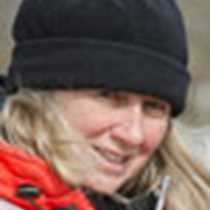Stanley, East Falkland, Falkland Islands
Forty knots of wind raced across the flat lands of East Falkland grasping the surface of Port William and whipping it into white caps. The dancing froth rolled along our sides and bounced back from the opposite shore in such a way that at our stern the surf was coming from opposing directions. Riding anchor we held our bow to the wind, waiting for the light of day. Morning arrived subtly with just a hint of blue and pink at the edges and the flaxen colors of fall grasses on land mixed with deep dark greens of low lying shrubs. By breakfast we were safely tucked into our berth at the FIPASS pier and ready to venture forth into civilization.
Even in the darkness of early morning, the glow from Stanley’s lights told us that life was to be different today. For more than two weeks we have been surrounded by wildness. Our tiny community has meandered from place to place and at each site we found only ourselves and the wildlife living there. How easy it was to forget the sounds of traffic and the trappings of modern day life. Tiny Stanley, population 2,000, was perhaps a good locale to stage our reentry. Buses murmured on the dock waiting to bear us in many directions. The museum, a farm, a greenhouse or town, were the morning destinations. No matter which outing we joined, it became apparent that life everywhere is a matter of choices. There was the choice to live in town with all of its commercial expectations or live in “the camp,” the country, doing with less materially but more in touch with the land. Here in the Falklands a few choose to still cut the peat and warm their hearths with the fragrant smell of its burning. Some rise early to herd the sheep or milk a cow or just to stand and listen to the bray of a Magellanic penguin. Others work in government offices or the schools or hospital settings or tend their shops that periodically are visited by guests from far away. Who is to say which is better? Each must choose his or her own path.
Quartzite highlands rose above the harbour and from the top of Tumbledown could be seen a most impressive view. Stone runs (periglacial block fields) appeared to cascade from the uplifted ridges like water tumbling downhill from a mountain lake. Diddle-dee carpeted the dark turf bearing red or purple fruits waiting for the picking and the making of preserves. Tall fern fronds wove in the breezes but small fern simply laid flat upon the ground joining a myriad of other “belly plants.” Firm mounds of balsam bog seemed to grow directly from massive boulders. Even though we looked down upon the town and many tiny farmsteads, the exhilaration of being amidst the natural vegetation dominated. A moment of sadness gripped us as we reached the crest and paused to remember those who lost their lives on that very spot in 1982 when two countries solved their differences with arms rather than negotiations.
Back at sea darkness is ushered in by a crimson sky and we sail from the quiet of the harbour bound for the northern edges of the isles.




